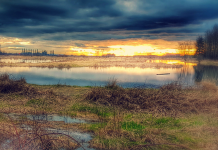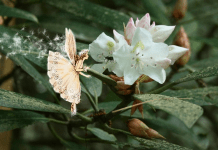
 The Witches’ Almanac, Water: Our Primal Source, Issue 36, Spring 2017-2018
The Witches’ Almanac, Water: Our Primal Source, Issue 36, Spring 2017-2018
The Witches’ Almanac Ltd., 978-1881-09839-3, 206 pp., 2016
It’s hard to categorize The Witches’ Almanac. One part traditional almanac and two parts eclectic and topic-spanning information, this guide is a roadmap for spring 2017-2018 and beyond. This particular issue’s theme is water — how it is the biggest part of our physical makeup and the Earth’s, and how “power and magic in all its forms ebbs and flows all around us.”1
What is it about The Witches’ Almanac that makes it a keeper beyond the specific almanac date period? The scope and breadth of the various articles and short pieces within its pages.
Articles range from “The Blessed Raven,” the story of Bran the Blessed,2 to binding spells throughout the ancient world,3 to articles and stories grounded in folklore such as the riveting “Mother Winter’s Antlers,”4 and overviews of people important to Paganism and spirituality‘s history in “Sir Arthur Conan Doyle: Explorer, Author and Spiritualist.”5
Naturally, the almanac is sprinkled with articles featuring the focus of the issue: water. The issue begins with the lyrical, “A Hymn in Praise of Neptune.”6 Then there was “The Sacred Acre.”7 Although I’d never heard of this concept before, I loved the title. Here’s how the author, Ivo Dominguez Jr., describes the sacred acre:
There is a place called the Sacred Acre which is the land that lies between the marks of the low tide and the marks of the high tide. It is the land that belongs to both the spirits of the Sea, and the spirits of the Land. The Sacred Acre, like the tides, is always in flux as it moves along the seashores of the world.
It’s a place of liminality, a threshold into other realms, where magick rises and falls like the tides. These in-between places transform. Part of the piece describes how to walk the boundaries of the sacred acre, and, if one doesn’t live near the sea, how to bring that magick into your home. Anyone who’s had the pleasure of walking the sacred acre knows the power in the pull of the tides, the wheeling cries of the gulls, and the whip of the air. That transformative power of place seeps into every pore of your being.
The water theme continues with “Notable Quotations” on water8 and “The Fathomless Mystery of the Sea,”9 in which the author describes how to make a cancer crab protection charm.
Of course, as with any good almanac, the coming year’s weather, health, and astro-outlook is included. There’s the “Moon Gardening by Phase” piece,10 and the “Moon Calendar,”11 which is interspersed with short pieces such as, “A Thessalian Moon Charm;”12 a talisman page featuring “The Helm of Awe;”13 and a page of kitchen magick featuring the Swedish Yule drink, Glögg.14
The Witches’ Almanac employs its own meteorologist who provides the Almanac’s section, “Window on the Weather,”15 which offers a general overview of each season and every month within that particular season. The “PreSage” section of the Almanac16 by Dikki-Jo Mullen, helps the reader navigate one’s birth sign in general terms for the coming year from spring 2017 to spring 2018.
What I love about The Witches’ Almanac is the international flavour of the variety of subjects and articles. There’s “Fairy Beliefs in Rural France,”17 which covers a whole host of les fées; the folkoric belief in Finland and Sweden about the Easter Witches18 where the witches get candy from celebrants; “Tom Smith’s Bon Bons: A Tale of English Magic,”19 in which the history of English crackers is explored; and finally an overview of Graeco–Egyptian magick.20
The sheer variety of information contained within The Witches’ Almanac makes it a keeper no matter what year it covers. From the practicality of the moon gardening by phase, to the moon calendar, to ghost stories rooted in reality like Bloody Mary21, and an exploration of Sir Arthur Conan Doyle, The Witches’ Almanac — Water: Our Primal Source, beckons the reader to return again and again to imbibe of the deep well of information it provides.
- Preface. [↩]
- p. 12-14 [↩]
- p. 20-29 [↩]
- p. 144-1445 [↩]
- p. 146-149 [↩]
- p. 7 [↩]
- p. 24-27 [↩]
- p. 72 [↩]
- p. 102-105 [↩]
- p. 42 [↩]
- p. 43-73 [↩]
- p. 44 [↩]
- p.58 [↩]
- p. 68 [↩]
- p. 81-85 [↩]
- p. 157-183 [↩]
- p. 132-135 [↩]
- p. 140, 141 [↩]
- p. 118, 119 [↩]
- p.30-33 [↩]
- p.106-108 [↩]








